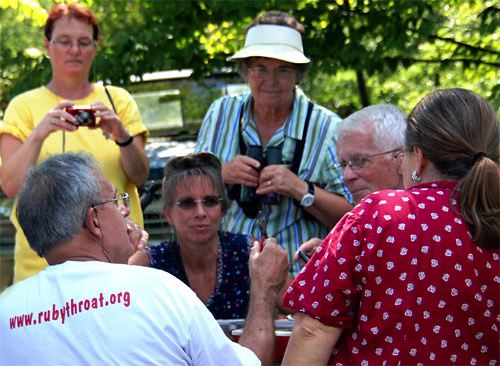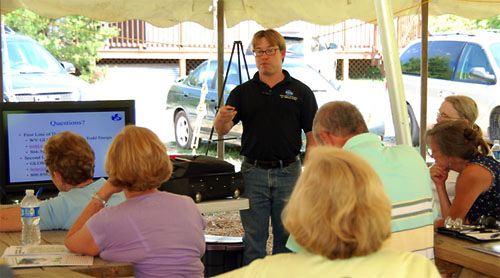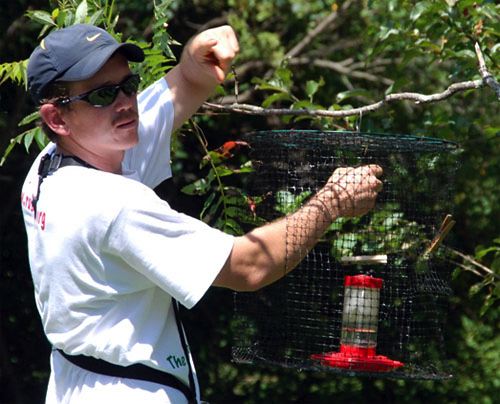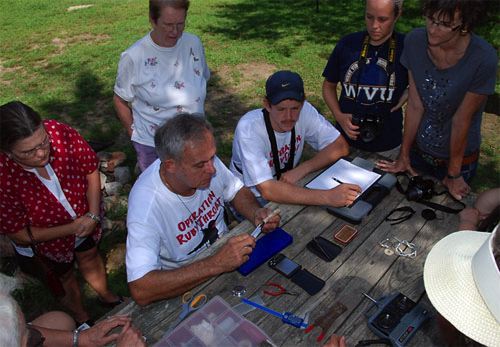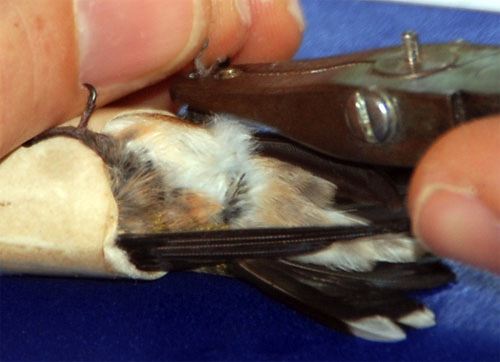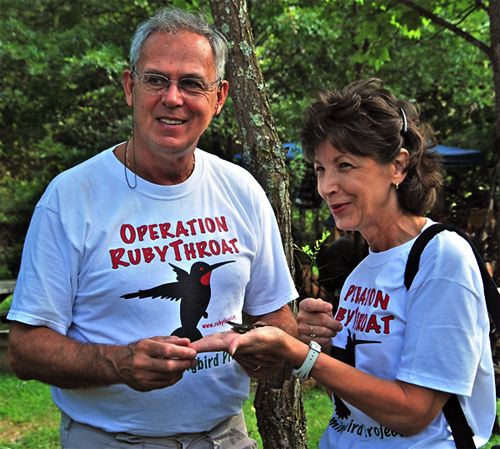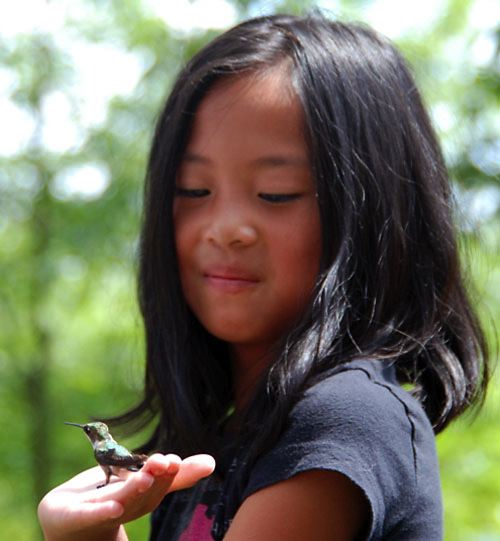|
|
|||
|
(Back to Preceding Week; on to Next Week) |
|
|
|
IN THE MOUNTAIN STATE: Since 2003, we've been fortunate to be involved as lecturer and bird bander at the New River Birding & Nature Festival held each spring in Fayette County WV.
We proposed a three-day affair, with an intensive six-hour Friday workshop on attracting and observing hummingbirds for teachers, naturalists, and citizen scientists; a Friday evening lecture for ages 12 and older; and all-day hummingbird banding demonstrations for the general public on Saturday and Sunday. This schedule has worked quite well for us at other locales so we believed we could implement it successfully in West Virginia's southern mountains. The hard part was finding an appropriate venue--except for a top-notch Wetlands Boardwalk there are no facilities yet at the New River Birding & Nature Center--but upon thinking about it a while Dave determined ACE Adventure Resort at nearby Minden WV could be just the right spot. Early this past spring after ACE management showed real enthusiasm at the promise of hosting an event both educational and scientific, we visited the 1,500-acre multi-use facility and identified a habitat we predicted would be occupied by Ruby-throated Hummingbirds six months hence. Planning a hummingbird festival without knowing there was an established population of ruby-throats was a bit of a gamble but, heck, we always welcome a challenge.
All text & photos © Hilton Pond Center Dave and Rachel faithfully maintained for the next six weeks, keeping the hummingbirds interested until we finally journeyed to West Virginia for festival weekend. As planned, we met with workshop attendees on Friday morning and provided deep background about results of our 27 years of Ruby-throated Hummingbird research here at Hilton Pond Center. Along the way we described some of our interesting discoveries during ten expeditions to ruby-throat wintering grounds in Costa Rica and Belize and spent a good bit of time detailing other aspects of hummingbird natural history.
All text & photos © Hilton Pond Center We also provided the group with instructions on how to make systematic, scientifically valid observations about hummingbird migration, feeding behavior, and nesting phenology and how to report such info The GLOBE Program and EarthTrek. We were pleased old friend Todd Ensign (above center), West Virginia's state coordinator for GLOBE, was able to come down from his office in the NASA Facility Educator Resource Center in Fairmont to greet, instruct, and officially enroll workshop participants as "GLOBE citizen scientists." We appreciate Todd's input and look forward to receiving data submissions from the 22 new enrollees.
All text & photos © Hilton Pond Center We were even more excited that Ernesto Carman Jr. (above)--the talented young Costa Rican naturalist who discovered a dense wintering population of ruby-throats in his home country--was able to fly north this summer for the New River Hummingbird Festival. Ernesto, who has served as expert guide for all our Central American expeditions, has become a full collaborator during our tropical hummer studies and added to the instructional activities in West Virginia by providing his own illustrated talk about some of the 50 hummingbird species that reside year-round in Costa Rica. Always at the ready, Ernesto also provided inestimable help in helping catch hummingbirds by baiting, setting, and monitoring several Dawkins-style traps (above).
All text & photos © Hilton Pond Center Ernesto worked hard all weekend setting traps, peddling our ever-popular Operation RubyThroat T-shirts (proceeds from which help support our hummingbird research, education, and conservation endeavors here and in the Neotropics), and accurately scribing hummingbird measurements and other data during the banding process (above). During an afternoon banding session, workshop attendees got very detailed information about the history and importance of the U.S. Bird Banding Laboratory, instructions about how to report a banded bird, and an explanation of what banding can tells us about bird migration, longevity, site fidelity, and general population dynamics. When we live-trapped Ruby-throated Hummingbirds, each group member got an intimate view of this smallest nesting species in West Virginia--all to empower participants to become better observers and reporters of RTHU behavior on the hummers' North American breeding grounds.
All text & photos © Hilton Pond Center After the intensive all-day Operation RubyThroat-GLOBE-EarthTrek workshop adjourned we took a dinner break before returning to ACE Adventure Resort for an evening lecture attended by the general public--including some of the 2,000 folks camping, swimming, hiking, horsebacking, and/or rafting at ACE that weekend. During the post-lecture question-and-answer period we invited all in attendance to come back Saturday and/or Sunday for hummingbird banding demonstrations and were pleased when many folks did just that. (One of those people, Bob Patton, drove down from Ohio for a mini-reunion at which we reminisced about his time with us as a member of our Crazy '08s Omega hummingbird expedition to Costa Rica in 2008. And while we're in a parenthetical note, we'd like to thank Lynn Pollard for greeting and orienting folks who came to the New River Hummingbird Festival on Saturday.) During the two days we caught, measured, banded (above), and released a succession of RTHU and--as during the intensive Friday workshop--explained how banding works and why the federal Bird Banding Laboratory is worthy of our tax dollars. We also showed how a hummer band is made and applied one without harm to each bird's tiny leg, after which we randomly selected a member of the audience to help us release the now-banded ruby-throat (below, as with Karen Martin).
All text & photos © Hilton Pond Center Although each bird's band number will become part of the Bird Banding Laboratory's permanent database and will allow information exchange should one of our West Virginia hummers be encountered elsewhere, the real value of these public banding sessions is to give folks a greater understanding of how scientists work with wild birds and what we learn from such work. In our 30-plus years of experience in classroom and outdoor science education, nothing we've done with students of all ages has had a greater impact than allowing them to observe and participate in the bird banding process. And nothing has been more effective in stimulating these folks to think about birds, about habitat, and about why it is important we humans find ways to coexist with--not dominate--the natural world.
All text & photos © Hilton Pond Center Jillian Oar (above), a seven-year-old nature enthusiast from Daniels WV, was one of several people who gently helped release a hummingbird after the banding process. It's apparent from the priceless look on Jillian's face she was more than a little fascinated by the opportunity, and we're certain she won't soon forget how a real, live Ruby-throated Hummingbird magically perched on her hand for a moment before zipping into the lush West Virginia woods. Jillian's father, Dr. Paul Oar, wrote to thank festival organizers for what he dubbed "a great presentation--very interesting and informative--and an unforgettable life-experience for my daughter." Way to go, Jillian. We hope after this special "life-experience" you'll even consider becoming a member of the next generation of bird-banding ornithologists in West Virginia, at Hilton Pond Center, or beyond. See you next August at the 2nd annual New River Hummingbird Festival! All text & photos © Hilton Pond Center
|


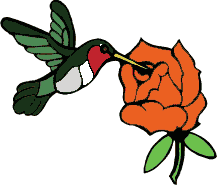 "HUMMINGBIRD MORNINGS"
"HUMMINGBIRD MORNINGS"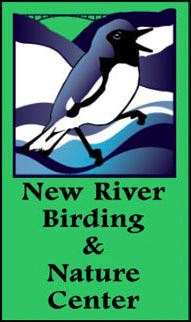 This annual event draws expert guides and ebullient attendees from across North America and provides one of the best birding experiences available anywhere. The festival was initiated, in part, to draw folks to the New River Gorge Region in spring before the whitewater rafting season gets underway, but we suggested frequently to co-organizer Dave Pollard that a late-summer New River Hummingbird Festival might also be of interest to birders and hummer fans. Last year Dave finally agreed and with the help of Vista volunteer Rachel Davis began laying plans for a hummingbird-based event to be held in mid-August 2010, under the auspices of Fayette County's recently established New River Birding & Nature Center (above left) at Wolf Creek Park.
This annual event draws expert guides and ebullient attendees from across North America and provides one of the best birding experiences available anywhere. The festival was initiated, in part, to draw folks to the New River Gorge Region in spring before the whitewater rafting season gets underway, but we suggested frequently to co-organizer Dave Pollard that a late-summer New River Hummingbird Festival might also be of interest to birders and hummer fans. Last year Dave finally agreed and with the help of Vista volunteer Rachel Davis began laying plans for a hummingbird-based event to be held in mid-August 2010, under the auspices of Fayette County's recently established New River Birding & Nature Center (above left) at Wolf Creek Park.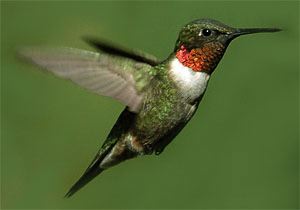 Thus, with visions of hummers in our heads, we showed Dave where to place feeders starting in early July, confident "if we build it, they will come." Sure enough, when Dave went back to freshen the feeders four days after he first hung them, he called us with exciting and welcome news: Nearly all the sugar water was gone and Ruby-throated Hummingbirds (adult male, above left) were "all over" the feeders. With hummers frequenting our designated site we were now certain the inaugural New River Hummingbird Festival in August 2010 would be a success--especially after our all-day instructional workshop scheduled for Friday and limited to 20 people filled up as soon as it was announced.
Thus, with visions of hummers in our heads, we showed Dave where to place feeders starting in early July, confident "if we build it, they will come." Sure enough, when Dave went back to freshen the feeders four days after he first hung them, he called us with exciting and welcome news: Nearly all the sugar water was gone and Ruby-throated Hummingbirds (adult male, above left) were "all over" the feeders. With hummers frequenting our designated site we were now certain the inaugural New River Hummingbird Festival in August 2010 would be a success--especially after our all-day instructional workshop scheduled for Friday and limited to 20 people filled up as soon as it was announced.